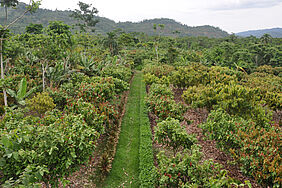Wiebke Niether, Johanna Jacobi, Christian Andres, Wilma Hart and Laura Armengot from University of Göttingen (Germany), the Centre for Development and Environment of the University of Bern, ETH Zürich and the Research Institute of Organic Agriculture (FiBL) have published a meta-analysis in the Journal Environmental Research Letters comparing the agronomic, ecological, and socio-economic performance of cacao agroforestry systems and monocultures.
The results of the meta-analysis indicate that cacao agroforestry systems have the potential to compete with cacao monocultures in terms of economic performance and outperform them in crucial system services, such as climate change mitigation and adaptation, as well as total system yields. A knowledge gap was identified regarding biodiversity conservation and pest and diseases. Still, the few articles found showed that agroforestry systems exhibited a significantly higher biodiversity and performed similarly or better than monocultures in terms of pests and diseases. The combined results underline the potential of agroforests to improve the sustainability of cacao farms.
Despite the benefits of cacao agroforestry systems mentioned above, the often lower cacao yield in agroforestry systems might still be one of the most relevant factors hindering a broader adoption of diversified production systems. Further research focused on increasing cacao yields in agroforestry systems is therefore necessary (e.g., breeding for shade-tolerant varieties or adapted management practices to increase pollination rates). Also, building and enabling access to new markets and value chains for agroforestry products is essential to promote agroforestry production systems. Farmers should be compensated for the reductions in cacao yield through fair prices for sustainable cacao and/or carbon sequestration initiatives.
The study also identified the need to address knowledge gaps on the role of different shade trees, farm management strategies, pricing policies, cultural and social services of agroforests, and livelihood aspects. The study was funded by the Swiss Cocoa Platform, with co-funds of the SysCom programme (financed by Swiss Agency for Development and Cooperation (SDC), the Liechtenstein Development Service (LED), the Biovision Foundation for Ecological Development, and the Coop Sustainability Fund).
Further information
Contact
Laura Armengot Martínez, FiBL Switzerland
Link
iopscience.iop.org: Cocoa agroforestry systems versus monocultures: a multi-dimensional meta-analysis




